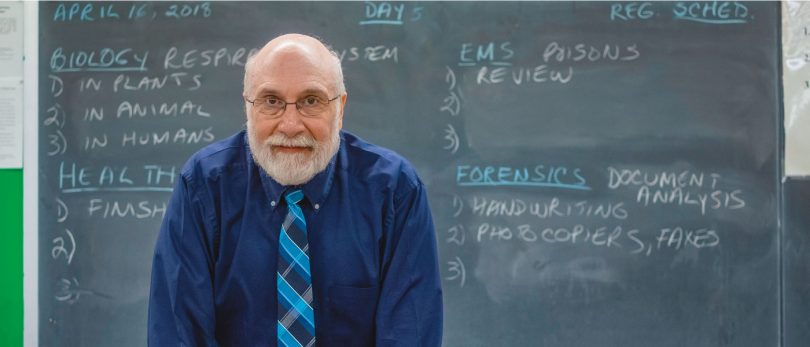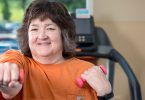Gregory DeAngelo lit the family’s gas barbecue and it ignited with a louder whoosh than usual. “I pulled my arm back from the flame and twisted it. I knew immediately that I’d done something to my rotator cuff,” Mr. DeAngelo recalls.
He pushed through the excruciating pain, although a year later the normally active, healthy, 67-year-old Binghamton resident still suffered chronic shoulder achiness and reduced range of motion—which was impacting his life. In his position as a high school teacher, writing on the classroom board had become uncomfortable. In the gym, diminished range of motion made lightweight resistance training difficult, something he enjoyed doing to stay in shape.
With everyday movements limited, Mr. DeAngelo made an appointment to see David Gallagher, MD, orthopedic surgeon and sports medicine specialist at the UHS Orthopedic Center.
A Rare Opportunity
An MRI confirmed that Mr. DeAngelo had an irreparable rotator cuff tear, which had progressed beyond standard rotator cuff repair methods due to the time between his injury and examination. Dr. Gallagher recommended a superior capsular reconstruction (SCR)—an advanced procedure that is not yet widely performed in the United States. However, Mr. DeAngelo was in luck.
Throughout New York’s Southern Tier, Dr. Gallagher is the first and only surgeon trained, skilled and experienced in SCR surgery. “It’s a technically demanding procedure, but for certain people with an irreparable rotator cuff tear, it’s the best solution,” Dr. Gallagher says.
To date, Dr. Gallagher has performed more than 250 successful superior capsular reconstructions, making him one of the most experienced SCR experts in the United States.
The Benefits Add Up
While an irreparable rotator cuff tear is often associated with the natural aging process, it can happen at any age due to a myriad of reasons. The trigger may be a hard fall on an outstretched arm or, as in Mr. DeAngelo’s case, a sudden, awkward twist of the arm. Repetitive stress can also cause a tear, such as constantly lifting heavy objects, swinging a golf club or throwing a ball.
Superior capsular reconstruction, which is a minimally invasive, outpatient procedure, provides a relatively new, advanced alternative to treat an irreparable rotator cuff tear in younger, active patients with no arthritis. Prior to the SCR procedure, a reverse total shoulder replacement was the only solution to reduce pain and restore shoulder function.
A noted benefit of SCR is its lack of post-procedure weight restrictions. “After a superior capsular reconstruction heals, patients have no weight limitations. It’s life as usual before the tear,” Dr. Gallagher explains. “On the other hand, after a total joint replacement you have a weight restriction and can’t lift heavy objects without risking stability of the prosthesis. Can you imagine a 10-year-old with that kind of restriction?”
There’s another benefit. “SCR allows me to preserve native bone and cartilage,” Dr. Gallagher says. “This benefit helps achieve a permanent solution from pain, returned range of motion, original strength—and all without any weight restrictions. Being able to work with native bone also helps avoid possible side effects associated with total joint replacement, such as implant failure or dislocation, a higher infection rate and decreased post-op strength.
“So if a patient’s shoulder joint is not arthritic and has a healthy cartilage, completely replacing the shoulder joint with a prosthetic joint is excessive and a salvage procedure,” Dr. Gallagher emphasizes.
An In-Depth Look
To appreciate this innovative procedure, it helps to first understand the shoulder’s anatomy.
The ball-and-socket shoulder joint, called the glenohumeral joint, is formed by the head of the humerus (upper arm bone) fitting into the cavity of the scapula (shoulder blade). The resulting joint, which allows the shoulder to move in all possible directions, is surrounded and supported by a group of four muscles called the rotator cuff.
When a tear in the muscles qualifies for superior capsular reconstruction, the patient reclines in a chair while the surgeon uses a tiny, illuminated device, called an arthroscope, to insert, place and anchor a graft onto the existing weakened rotator cuff. This graft, which acts as a tendon, helps other muscles compensate for the torn rotator cuff and keeps the head of the humerus bone from slipping out of the glenoid.
It’s this strong stability that relieves pain, restores shoulder function and delays or prevents development of arthritis in the shoulder joint.
Dr. Gallagher cites two recent studies that show how the graft revascularizes into the patient’s own tissue within one year—meaning the body incorporates the graft into the shoulder joint, accepting it as a “native” tendon rather than a foreign patch. This, Dr. Gallagher stresses, is a significant reason for little or no rejection of the graft post-procedure.
Life As Usual
Once the healing process is complete, pain and disability are significantly reduced or completely relieved. In Mr. DeAngelo’s case, it was a quick recovery, full pain relief and complete range of motion restored. “Dr. Gallagher suggested I stay away from heavy weight lifting—to prevent another tear—but that wasn’t something I ever did anyway. So, as far as my life goes, the surgery was a complete success. I couldn’t have asked anything more from Dr. Gallagher. I have plenty of strength, and I’m back 100 percent.”
LEARN MORE
Learn more about our new UHS Orthopedic Center physicians.







